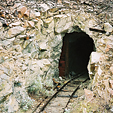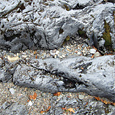How To
Ask the Experts
December 2012 by Chris Ralph
Q: My questions are in the legal arena, but I’m thinking you may have the experience to know about it, or at least comment on it. Here is my situation:There’s a patented lode claim with property taxes current so it’s in good standing. Over the top of that are filed 16 unpatented claims, but the boundary lines don’t match up (are not parallel) with the boundary lines on the patented claim. They’re off maybe 20-30 degrees, so there’s a situation where there are sections (pieces or parts) of unpatented claims gridded over the patented claim creating odd shaped angles/triangles, with the balance of intersecting unpatented claims lying outside the patented claim boundary.
My question has to do with “void” claims, or maybe a better description... “voidable” claims. From what I’ve read, BLM does not like to get involved in situations like these, telling folks to go get an attorney and deal with it that way. I’m trying to understand what the rights are for the patented claim holder and the unpatented claim holder in this situation.
Any portion of any unpatented claims lying on top of the patented claim area should be void, but what about the remainder of any void unpatented claim that lies outside the patented area? Is it also automatically void? In other words, is any unpatented claim that intersects a patented claim completely void in its entirety because of an intersecting piece? Is the area that overlaps the patented claim or the outside area “voidable,” requiring action to be taken by the patented claim holder to achieve void status? If yes, who can take the action necessary to void that “outside” area? Only the patented claim owner?
And finally, are there circumstances where the “outside” area would not be void or voidable? I’m reading some info that suggests as long as the lode markers aren’t inside the patented area, that perhaps the “outside” area of the crossover unpatented claim may be in good standing. Got any words of wisdom? Thanks for input, and I enjoy the magazine and your articles.
Steve
A: First of all, I want to note that it is very normal to have someone blanket over your claims in the way that you have experienced. Many people I know have had this same experience, and I even have a set of unpatented claims in Nevada that were blanketed over by a mining company years ago.
Second, you are right that BLM does not want to set itself up as judge over these sorts of disputes. Often the decision hinges on minor details and actions of the claimants, and they’re simply not set up to collect testimony, evaluate evidence and make judicial decrees the way the courts are. Lots of claim owners would like the BLM to make simple decisions like that, but our legal system just doesn’t work that way. Besides, any decision made by the BLM can be challenged in court.
You may have read in this magazine an article I wrote some months back about a large mining company in Nevada that failed to file its 2011 unpatented claim paperwork or pay the necessary fees. Shortly afterward, a second mining company staked over the ground and a few months after that the BLM sent the first company a notice that their old claims were now null and void. However, this was not the end of the matter, and the two sides are still fighting in court. Even though the first mining company freely admits that they failed to comply with the law in filing the necessary paperwork and paying the necessary fees, they still believe that their claims to the ground are valid and that the BLM was wrong in voiding them. The court will decide whose claims are valid sometime late next year.
In taking a look at your situation, I can tell you that just because an unpatented mining claim partly overlaps an existing patented claim, it is not automatically void. As you noted at the end of your comments, so long as the location monument and discovery are not on the patented claim, the adjoining unpatented claim may well be perfectly valid. Of course, the portion that is covered by the patented claim is owned by the property owner and cannot be taken away by filing an unpatented claim. Mining claims can only be filed on federal land (though there are some cases where the surface rights are privately-owned, but the federal government owns the mineral rights), so the patented claim owner holds the right to his ground. I don’t know if the unpatented claim owners did their homework and located all the monuments properly, because it would seem, like in your case, the validity of the adjoining unpatented claims would hinge on those issues.
If you wish to have some of the claims voided, it will have to go through the courts and the unpatented claim owners will have to have their rights determined through the due process of the legal system. There is no question that such a procedure can be a very expensive process. Unfortunately, there is no cheap alternative to going through the legal system.
Finally, we come to the practical end of things, my thoughts and opinions on what I might do in a similar situation. First, I would send a letter to the unpatented claim owners letting them know that I own the patented claim, and that they are not authorized to trespass or do any exploration or mining work on my property. I would also send a notice to the BLM that these claims conflict in part with existing patented mineral claims. I would also ask the BLM to be sure to include my letter in their file (and be sure to send the letter to the BLM office in your state where the files are kept).
The other possibility is that you may decide to offer them some sort of lease arrangement. That was what I did. I still have my claims that I mentioned were blanketed over at the beginning of my comments—I leased them out to the exploration company. In fact, as I write this, they are currently drilling my property and finding gold and silver ore. That sort of possibility may or may not appeal to you, it just depends on your goals and plans as far as what you intend to do with the property.

Route Planning Using GPS
 My intention was to end this discussion with waypoints and routes, then I found USGS maps of the Plainfield Quadrangle.
My intention was to end this discussion with waypoints and routes, then I found USGS maps of the Plainfield Quadrangle.
The Basics of Permitting and Bonding Your Mining Operation
 With the recent surge of interest in gold projects, it’s about time to revisit a subject that strikes fear into the hearts of small-scale miners: Permits.
With the recent surge of interest in gold projects, it’s about time to revisit a subject that strikes fear into the hearts of small-scale miners: Permits.
Shaker Tables for Processing Hard Rock Ores
 Most placer equipment is really made with gold in the 30 and larger mesh sizes in mind, though if carefully used can often get reasonable recovery down to the 50 mesh size.
Most placer equipment is really made with gold in the 30 and larger mesh sizes in mind, though if carefully used can often get reasonable recovery down to the 50 mesh size.
A Few Pointers About Cracks and Crevices
 Because these crevices catch and hold gold so well, it's worthwhile to learn how they form, which ones are good for catching gold and which ones are not.
Because these crevices catch and hold gold so well, it's worthwhile to learn how they form, which ones are good for catching gold and which ones are not.
Cutbacks at S. African Mines—Britain Blamed
South African gold miners are turning their anger towards Britain, charging that the sale of 25 tons of gold by the Bank of England has depressed gold prices and put them out of work.
Ask The Experts
Which comes first, claim filing or staking?
Prospecting for Copper—What to Look for on the Outcrop
 For the prospector, knowing what oxidized hydrothermal alteration looks like in the field is an important exploration tool.
For the prospector, knowing what oxidized hydrothermal alteration looks like in the field is an important exploration tool.
Subscription Required:
The Bawl Mill
• Ask the Experts
• Legislative and Regulatory Update
• Prospecting for Gold at Green Valley
• Extraction of Precious Metals Using Froth Flotation
• Detecting Old Ground Sluice Locations
• Mineral Deposit Trends: Real and Imaginary
• Four Arrested for California Mining Museum Heist
• Scams, Scammers and Schemes
• Lawsuit Update From the New 49'ers
• Constitutional Sheriffs Standing Up for Our Rights
• What's Left Behind
• Melman on Gold & Silver
• Mining Stock Quotes and Mineral & Metal Prices








